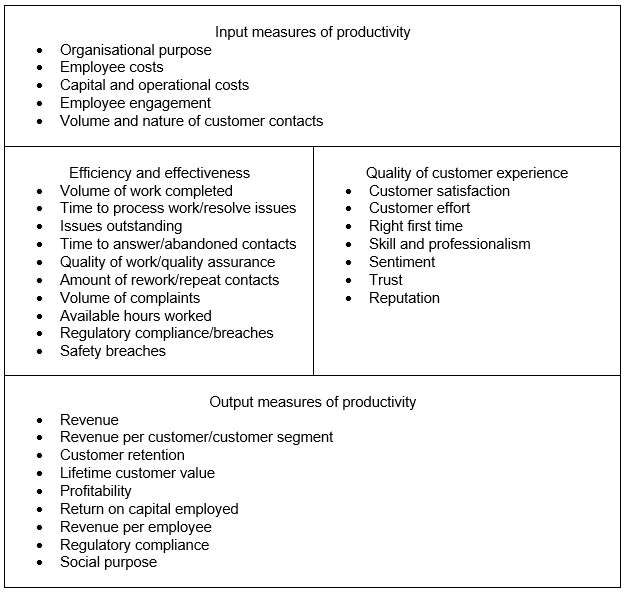Even before the Covid-19 crisis, productivity was a fundamental challenge for the economy UK productivity has tended to lag behind that of many other advanced countries and has been slow to recover since 2008. In the context of the financial and operational challenges emerging from the Covid-19 crisis, improving productivity has a renewed urgency: it could make the difference between business survival or failure.
Productivity in a service context has distinct characteristics
Inputs are often diverse, include different sets of employees, premises, information and technologies. Customers are both influencers and consumers of service productivity through their interactions with organisations. Customers also influence the behaviour of other customers through recommendation and word of mouth. Activities that appear to reduce cost and improve productivity may cause extra customer contacts and rework, resulting in added costs and deterioration in customer satisfaction. Rather than focusing on service productivity only in narrow, transactional term, organisations should focus on the relationship between efficiency and effectiveness, the quality of customer experience and the organisation’s key purpose and goals.
A choice between improving productivity and customer service?
Some business stakeholders see customer service as essentially a cost to the organisation and that there is a choice to make between either productivity or customer service. However, our evidence suggests that improving service productivity offers significant opportunities to reduce effort and generate value for both customers and the organisation. Key potential “game changers” for service productivity are a mix of employee engagement alongside deployment of technology that automates, speeds up and simplifies key processes and interactions.
In this guide, we set out practical steps to help organisations improve customer service, productivity and business performance.
1) Make the case that focusing on customer service will improve productivity
– Elevate the productivity agenda from a narrow, transactional one by highlighting the “whole life” cost and value of customer engagement
– Highlight the amount of time spent on dealing with problems for customers caused by your organisation or a supplier
– Find evidence, from your organisation and other sources about the link between high levels of customer satisfaction and better financial performance
2) Understand why and how customers interact with your organisation
– Identify customers’ objectives and the extent to which they are achieved
– Measure customers’ perceptions of your quality of service
– Map the customer journey: where employees are spending time and effort; the impact of internal hand-offs and supplier relationships; and the extent of problems, repeat contacts and rework
3) Identify opportunities to reduce customer effort
– Activities that add no value
– Failures that cause problems or rework
– Activities that take longer than customer expectations to complete
– Measures that are misleading or unhelpful
4) Automate and simplify processes
Harness artificial intelligence, automation and process review to improve efficiency of back office processes and routine customer interactions. Examples could include:
– Redesign bills to reduce queries
– Access to information that answers straightforward queries
– Equip employees with information to select the right tools for the job
– Enable customer self-serve
– Integrate customer data sources
– Multi-channel contact packages to increase call handling efficiency
– Speed up payment processes
5) Engage, develop and empower employees
– Ensure all employees have an appropriate understanding of the organisation’s key purpose, values and objectives and how their role relates to them
– Recruit for an appropriate mix of attitude and technical competence and experience
– Develop employees’ skills in emotional intelligence, customer relationship management, commercial awareness and judgement
– Ensure all employees have a personal development plan or pathway
– Equip line managers with the skills and capabilities to engage effectively with their team including coaching, decision-making and accountability and performance management
– Encourage employees to collaborate to solve problems and produce ideas to improve productivity and customer satisfaction
– Enable employees to spend more time dealing with complex issues and creating value for the customer and the organisation
– Conduct regular, relevant and authentic communication with employees
– Give recognition to employees’ contributions in improving productivity and customer satisfaction
6) Address potential barriers to improving productivity
– Demonstrate fairness in pay and incentives for employees.
Although pay and benefits are generally not strong drivers of positive employee engagement, unsatisfactory compensation can undermine engagement. Employees – especially the most highly engaged and the lowest paid – see pay and incentives as the most significant barrier to their organisation improving its productivity.
– Align individual performance measures and the organisation’s customer satisfaction and financial objectives to promote desired employee behaviours and competences
Be transparent about how the organisation measures customer satisfaction, productivity and business performance
7) Set measures of productivity that your organisation’s purpose; efficiency and effectiveness; customers’ perception of quality; business performance outputs
We have set out below an example template that can be adapted to different organisational contexts.
For further information, evidence and case studies about how to improve and measure service productivity and customer satisfaction see Productivity UK: Generating sustainable value from service.





Comments (2)